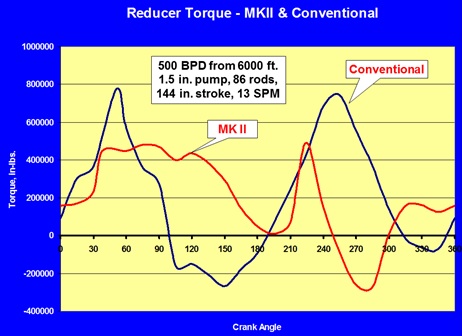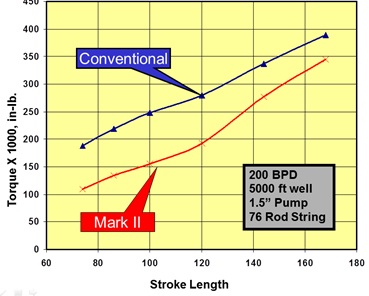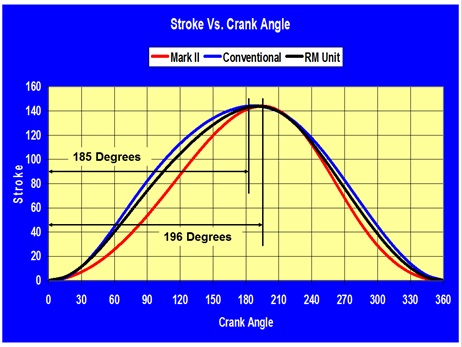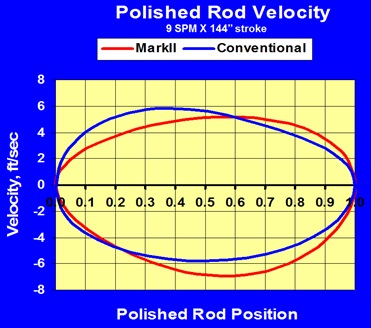This article helps understand the difference between Conventional & Mark II pumping units in term of production performance. SROD, the predictive program from General Electric (GE), has been used in order to compare the Reducer Torque Performance, the Stroke Length, and the Polished Rod Velocity, of a conventional unit and a Mark II unit. In order to do that, production data from the well MF-1 are used.
MF-1 is an oil well activated using a sucker rod pump. The target rate is 500 BPD, the pump is set at 6000 ft, the plunger diameter is 1.5 inch, the rod string is 86, the stroke length is 144 inch and the pumping speed is 13 spm.
Reducer Torque:
- Reducer Torque vs. Crank Angle:
SROD, the predictive program from GE, has been used in order to compare the reducer torque performance of a conventional unit and a Mark II unit. The plots “Torque (in in-lbs) versus the crank angle” are depicted in the following graph.
Note that the MKII does a better job approaching the uniform torque goal than the conventional unit and therefore has lower peak torque.

- Reducer Torque vs. Stroke Length:
This graph illustrates the torque required to lift the 500 BPD from 6000 ft. over a number of different stroke lengths for both the conventional and Mark II units.

Note that the Mark II requires less torque to do the same job for each stroke length. This is a common feature of the Mark II.
Stroke Length:
Stroke Length vs. Crank Angle:
This graph illustrates the number of degrees of crank rotation required to create the upstroke for the Mark II, the conventional and Reverse Mark (RM) units.

Note that the conventional unit makes the upstroke in 185 degrees in one rotation and 175 degrees in the other while the MKII takes 195 degrees of crank rotation to make the upstroke.
The MK II spends 5% to 12% more time in the upstroke part of the cycle. Therefore, it has 5% to 12% more time than the conventional for the pump to fill. During the upstroke, the pump is filling with fluid for the next lifting part of the cycle. For low pump intake pressures, this would allow more fluid to enter the pump.
Polished Rod Velocity:
This graph illustrates the relative polished rod velocity of both the conventional and Mark II pumping units throughout the complete stroke.

The lower acceleration on the upstroke of the Mark II clearly result is lower velocity for over 50% of the upstroke. This is returned to the cycle during the downstroke where the MKII is faster than the conventional for over 70% of the down stroke.
This faster downstroke of the MKII could cause more damage to a pump and rods if the pump was not filling properly with fluid because the pump plunger would hit the fluid at a higher rate of speed causing a shock to the system. Incomplete pump fillage can be sensed by a pump-off controller (POC) and the pumping unit shut down before damaging the pump and rods.
Generally speaking, compared to a conventional unit:
- The MKII requires less peak torque to do the same work.
- The MKII requires a smaller prime mover.
- The MKII uses less energy to produce the fluid.
You May Also Like…
- Why Rod Lift?
- All what you need to know about sucker rod pumping system
- 10 Types of Rod Pumping Units
- Beam Pumping Unit Principles and Components
- Surface Components of Sucker Rod Pumps in different languages





